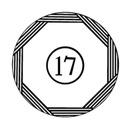In early Fall 1775, the 17th Regiment sailed for America in company with the 55th Regiment and other units. During the passage to America, the various ships carrying the regiment were separated by fall weather. The first four companies arrived in November and were first mentioned in General Orders on November 19, 1775, when Howe ordered that “The Companies of the 17th. Regiment to give their proportion for duty.” On December 11th, the regiment was reviewed by Major-General Clinton, although the six missing companies, along with a detachment from the 55th, do not appear to have arrived. The remaining six companies of the regiment arrived between December 25, 1775 and January 15, 1776 when Howe reported their arrival along with elements of the 55th Regiment on board the Grosvenor and Grand Duke of Russia Indiamen. The regiment served regular garrison duty with the other units at Boston.
On American Soil Again
On January 4th, the Light Company was detached to “do duty with Major Musgrave’s Corps of Light Infantry.” While aiding in the defense of Boston in the face of a tightening cordon of rebel units, the regiment was also training men in aimed fire, an invaluable skill in the service that would take up the next eight years of the regiment’s life. In February, the sergeants of the battalion companies exchanged their halberds for muskets, in accordance with Howe’s orders to that effect. On February 20th, Lieutenant The Honorable William Leslie purchased Captain Lyon's company, rising to become the junior-most captain in the regiment. He would achieve immortality while leading these men at Princeton a little under a year later. On March 16th, the regiment sailed with the rest of the evacuated Boston Garrison to Halifax, where they stayed until July. The army continued training, refitted, and re-organized, with the formation of two battalions each of Grenadiers and Light Infantry. The 17th Regiment received several new officers during this period. Lieutenant-Colonel John Darby was superceded by Lieutenant-Colonel Charles Mawhood, formerly Lieutenant-Colonel of the 19th Regiment of Foot, on April 4th.Captain Turner Straubenzee of the 17th Light Dragoons replaced Goodenough, who had retired on January 6th, as Major of the regiment on May 14th.On the same day, the battalions of Grenadiers and Light Infantry were formed. The 17th’s Light Company was detached to serve in the 1st Battalion of Light Infantry, while the Grenadier Company went with the 1st Battalion of Grenadiers. Major Straubenzee was detached to serve in the 2nd Battalion of Light Infantry. On may 16th, the 17th was assigned to the 4th Brigade under the command of Major-General Grant and were assigned to the Felicity and Liberty transports on May 18th, with a reported strength of 383 men.
The army sailed for New York in early June, arriving off Sandy Hook on June 29th. The 17th fought in all of the battles for New York City. After the island was secured, the 17th, as part of the 4th Brigade, was held in reserve during the Battle of White Plains and remained at the White Plains camp through the taking of Forts Washington and Lee and Cornwallis’s excursion through New Jersey. On November 24th, the 4th Brigade marched as the commander-in-chief’s escort on his journey to meet with Cornwallis, arriving in Trenton on December 8th. From there, the 17th Regiment was dispatched to Brunswick and Hillsborough before taking up quarters at Princeton with the 55th and 40th Regiments of Foot. With the campaign season approaching its formal close and winter setting in, the British army went into winter quarters spread throughout New Jersey.


